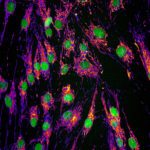Link to Pubmed [PMID] – 38288115
Link to DOI – 10.3389/fimmu.2023.1270268
Front Immunol 2023 ; 14(): 1270268
Several studies demonstrated that mitochondrial dynamics and metabolic pathways control T cell fate in the periphery. However, little is known about their implication in thymocyte development. Our results showed that thymic progenitors (CD3-CD4-CD8- triple negative, TN), in active division, have essentially a fused mitochondrial morphology and rely on high glycolysis and mitochondrial oxidative phosphorylation (OXPHOS). As TN cells differentiate to double positive (DP, CD4+CD8+) and single positive (SP, CD4+ and CD8+) stages, they became more quiescent, their mitochondria fragment and they downregulate glycolysis and OXPHOS. Accordingly, in vitro inhibition of the mitochondrial fission during progenitor differentiation on OP9-DL4 stroma, affected the TN to DP thymocyte transition by enhancing the percentage of TN and reducing that of DP, leading to a decrease in the total number of thymic cells including SP T cells. We demonstrated that the stage 3 triple negative pre-T (TN3) and the stage 4 triple negative pre-T (TN4) have different metabolic and functional behaviors. While their mitochondrial morphologies are both essentially fused, the LC-MS based analysis of their metabolome showed that they are distinct: TN3 rely more on OXPHOS whereas TN4 are more glycolytic. In line with this, TN4 display an increased Hexokinase II expression in comparison to TN3, associated with high proliferation and glycolysis. The in vivo inhibition of glycolysis using 2-deoxyglucose (2-DG) and the absence of IL-7 signaling, led to a decline in glucose metabolism and mitochondrial membrane potential. In addition, the glucose/IL-7R connection affects the TN3 to TN4 transition (also called β-selection transition), by enhancing the percentage of TN3, leading to a decrease in the total number of thymocytes. Thus, we identified additional components, essential during β-selection transition and playing a major role in thymic development.

